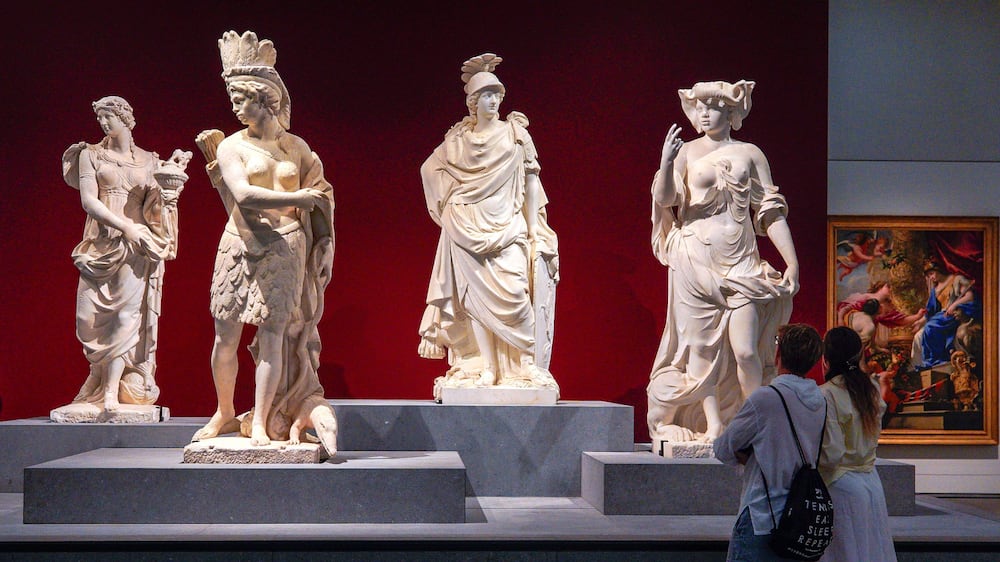Louvre Abu Dhabi has acquired three new works by Pablo Picasso, each of which exhibit a different aspect of his artistic approach. The museum also revealed a striking new loan: four giant marble sculptures known as the Four Parts of the World that have made their first trip away from their home at the Palace of Versailles.
Two of the Picasso works were hung in the museum’s fourth wing on Monday. The 1911 painting Woman Holding a Mandoline hangs on the opening wall of the wing, in a space once occupied by Piet Mondrian 1922 masterpiece Composition with Blue, Red, Yellow and Black.
“Woman Holding a Mandoline is welcoming the public to a new era, to the modern and present day,” Souraya Noujaim, director of scientific, curatorial and collections management at Louvre Abu Dhabi, tells The National. “It is the beginning of the 20th century, where they deconstructed figures visually and that was an important rupture.”
Woman Holding a Mandoline exemplifies Picasso’s heightened abstraction in Analytic Cubism. The subject of the painting and her instrument are barely identifiable. Faces and features emerge in rigid lines and ghostly strokes from the thinly layered backdrop of beige and ochre.
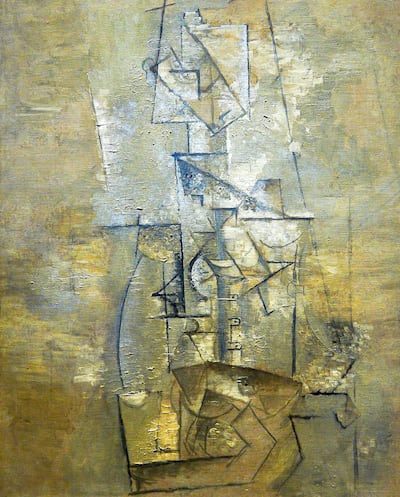
“It is the peak of analytic cubism,” says Guilhem Andre, chief curator of Louvre Abu Dhabi. The painting was created in the thick of Picasso’s artistic relationship with Georges Braque, who was also a pivotal figure in the development of cubism.
“They spent a few years building this cubism style,” Andre says. “The idea was to deepen the sense of reality and sculptural representation on a two-dimensional base.”
Picasso and Andre found inspiration in the forms and representations found in African art, which was stirring the imaginations of several European artists in the early 20th century.
“Collectors were gathering pieces of African sculpture, and [artists] were inspired by the different way of representing reality,” Andre says. “They couldn’t keep with the academic way of representing pieces and making portraits. They wanted a higher sense.”
Portrait of a Seated Woman (Olga) represents a completely different approach by Picasso. The 1923 painting depicts the artist’s first wife, Olga Khokhlova, seated with folded hands and a distant melancholic gaze. The work embodies Picasso’s neoclassical period, where he was inspired by sculptures from ancient Greece and Rome.
Khokhlova’s features are rendered in a manner that recalls Hellenistic and Roman depictions. Along with her hands, her face is painted with terracotta shades that pale in the light. Her dress and hair are painted in a tobacco hue with a fluidity that brings to mind watercolours or Indian ink. It also seems to pay homage to the sepia-like tints of photographs of the time.
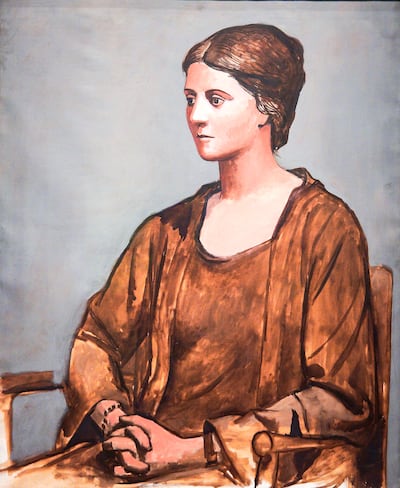
Picasso created several portraits of Khokhlova over the course of a decade. Portrait of a Seated Woman, however, is perhaps one of the most mysterious.
A ballet dancer, Khokhlova suffered in the relationship with Picasso because of his numerous affairs and their relationship deteriorated. They separated but as Picasso wouldn’t divide his property evenly with her, which was required by French law, Khokhlova stayed legally married to him until she died of cancer in 1955.
“Picasso’s first wife, Olga, was a ballerina, and you could see that in her posture,” Noujaim says. “It was not an easy relationship. This was painted during one of their separation moments. She helped him in his career and practice.
“We really thought that bringing Olga to the collection, as well as Woman Holding a Mandoline to the collection were key to telling part of the story of the great ruptures in art history,” Noujaim says.
Another Picasso work joining Louvre Abu Dhabi’s collection is Carnet no. 1076 – Studies of Yuri Gagarin. A series of 12 drawn pages and eight white pages, the works depict the nuances of Picasso’s pencil strokes, with some pages even showing traces of the drawing he made previously on the notebook. The pieces are scheduled to go on display later this year.
The studies were part of a series that Picasso created after being invited by poet Louis Aragon to design a symbol of peace for the First International Peace Conference in Paris in 1949. The sketch of the bird, depicted with five lines and an olive branch in its beak, would go on to become a universal emblem of peace.
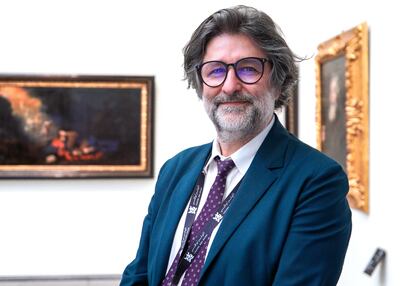
It was during this time that Picasso also drew Yuri Gagarin with a dove holding an olive branch. The portraits of the Soviet cosmonaut, who was the first to journey into space, were meant to symbolise the peace that Picasso was hoping for during the Cold War and the Space Race.
The Picasso works were acquired directly from the artist's family, a process that was years in the making, Noujaim says, and it was a happy coincidence that Louvre Abu Dhabi is revealing the new additions to its collection on the 50th anniversary of Picasso’s death as well as the fifth anniversary of the institution.
Louvre Abu Dhabi is finalising a rotation process of its artworks to mark the celebration and underscore its universal-museum model.
“It’s the same [universal] story but with different elements and ingredients,” Noujaim says. “It makes it obvious to understand the intention of Louvre Abu Dhabi. We talk about encounters of traditions, craftsmanship and materials. There are threads of these exchanges [throughout], how these exchanges were constructed and nourished. There are also questions of the image. You find them and follow them quite intuitively. It’s a sense of satisfaction for me, of a job accomplished.”
Another key work that expands on the universal and cross-cultural themes of Louvre Abu Dhabi’s narrative is Four Parts of the World, a series of monumental sculptures on loan from Musee National des Chateaux de Versailles et de Trianon.
Averaging 240cm in height, the four sculptures represent the continents as they were known at the time of Louis XIV’s rule. Installation of The Four Parts of the World sculptures in the museum was completed on Friday.
They were commissioned by the king as part of a group of sculptures created for the Gardens of Versailles. The ensemble of four was known since the beginning of the 20th century as part of the Grande Commande. They were designed by Charles le Brun, first painter to the king and grand designer of the decorations for the royal palace and its gardens. The sculptures were each created by a different artisan.
The sculpture depicting Europe, crafted by Pierre Mazeline, takes on the figure of Minerva, Roman goddess of wisdom, and is in draped clothing and a helmet. Trophies of arms are at her feet.
Asia, sculpted by Leonard Roger, is depicted as a woman crowned with flowers. She carries a smoking incense holder in her left hand, alluding to the spices and perfumes that came to France from the continent. A plume-topped turban is at her feet.
Africa, sculpted by Jean Cornu, is shown as a woman wearing an elephant headdress with a lion lying on the ground licking her foot. Finally, America, made by Gilles Guerin, is wearing a feathered headdress. A bow is in her hand and a quiver on her back. She stands over an alligator as well as the severed head of a European.
“It’s a pleasure receiving such an important sculpture in the third wing of the museum,” Jerome Farigoule, chief curator at Louvre Abu Dhabi says. “Versailles was very important for 17th and 18th sculpture works. In the gardens of the palace, you had some 800 sculptures. This was one of the most important ones. It was called Grande Commande, or the great commission.
The great commission included 24 statues across groups of four, including the Four Humors of Man, the Four Seasons, The Four Parts of the Day, The Four Forms of Poetry and The Four Elements.
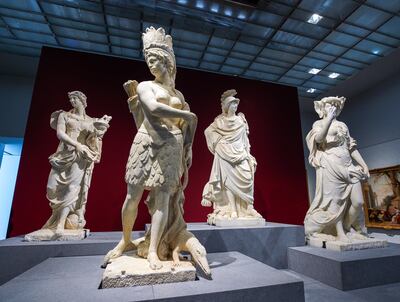
The placement of the statues within the museum is also significant, as it acts as a centre point to the allegorical works that dominated at the time, signifying that the statues, too, should be seen in an allegorical light.
It also exemplifies the wing’s dedication to the upsurge of globalisation that began at the time. This was especially true at the Palace of Versailles, where diplomats often visited from across the world as depicted in several paintings and sculptures of the time.
They were perhaps the most symbolic and political of the Grande Commande, bringing the entire world to the gardens of the French ruler, making him symbolically the centre of the world.
“He imagined himself to be the sun and all the planets, or continents, revolving around him,” Farigoule says. “It established France as a world empire.”
